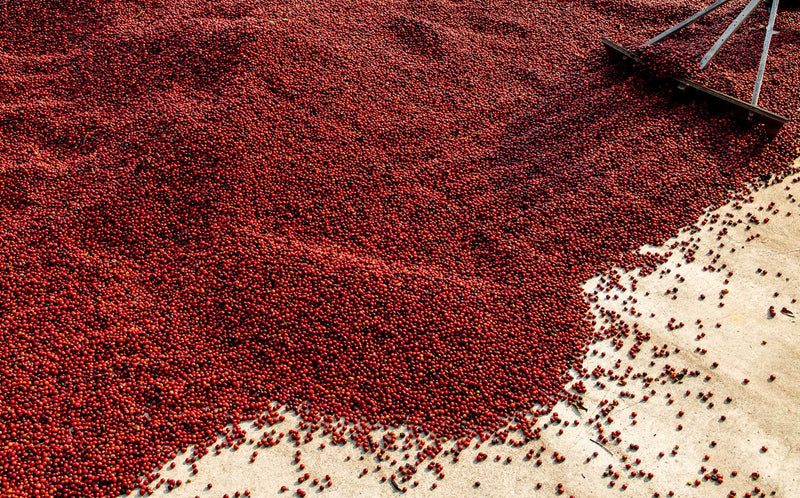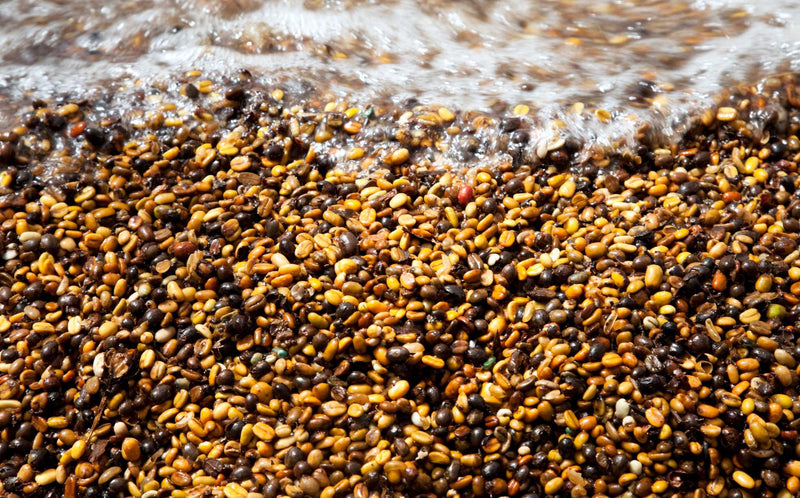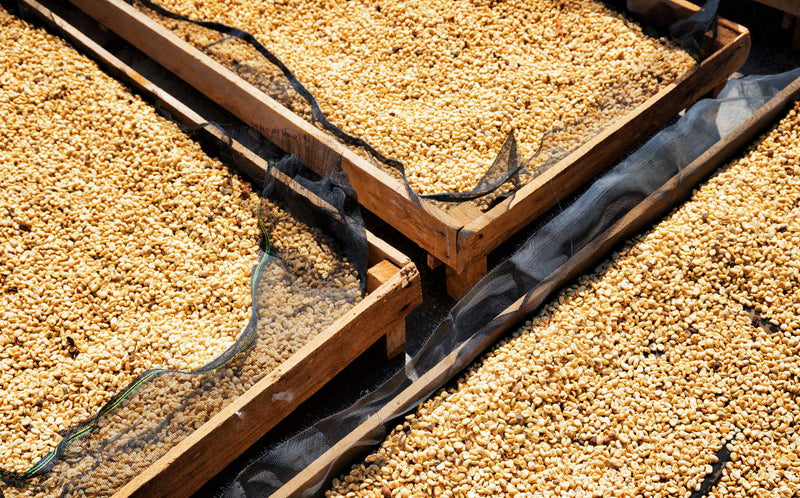Methods of processing coffee beans on the plantation
How does the processing of coffee beans take place once the drupes, the fruits of the coffee plant , have been harvested on the plantation ? This article will explore the most common processing methods whose terminology is often reported on coffee packaging, such as Natural, Washed, Honey and other experimental and innovative methods.
Coffee farmers in Coffee Belt countries pay great attention to coffee processing and are committed to producing a high-quality crop. Most of them are in fact aware that only an accurate process can enhance the taste and pleasantness of the final drink in the cup.
Before starting the journey through coffee processing methods it is important to know the anatomy of the coffee fruit .
The coffee fruit, known as a drupe, is similar to a cherry, and ripens to a red or yellow color for some varieties. Each drupe is composed of several layers : the colored external peel (exocarp), the mucilage or pulp (mesocarp), the parchment (endocarp) a rigid membrane and the film or "silver skin" that covers the two seeds.
These seeds are what we identify as the coffee bean.
What are the processing methods of coffee beans?
Immediately after harvesting, the farmer engages in coffee processing with the primary objective of separating the beans from the drupe pulp. The selection of the processing method is fundamental as it helps to shape the aromatic and taste profile of the coffee.
But what are the main methods used for coffee processing?
Natural or Dry Method (Natural)

The natural method , also known as dry processing of coffee, was originally developed in Ethiopia and represents one of the oldest and most traditional techniques.
The coffee fruits , after having been carefully collected and selected, are prepared for drying , in order to eliminate any impurities such as soil or small twigs.
The ripe drupes are then arranged for drying using various techniques : some prefer to place the coffee beans on concrete surfaces , while others opt to use raised beds which promote better air circulation. During this process, which can last up to four weeks, the drupes are constantly turned to ensure uniform drying. Afterwards, the pulp and skin of the green beans are removed via a mechanical process , after which they are left to rest before being sent for roasting . This method is mainly applied in regions characterized by long periods of sunshine and dry climate, such as Brazil, Ethiopia, Yemen, Mexico, Sumatra and Nicaragua.
Washed or Wet Method

Also known as wet treatment of coffee , the process known as the washed method is one of the most widespread, especially in coffee farms located at high altitudes and in countries where there is abundant rainfall.
With this processing method , the grain is initially separated from the pulp using a pulping machine . Unlike natural coffee, in the washed process the pulp is mechanically removed from the beans before drying. The beans are then immersed in tanks of water , where the remaining pulp is eliminated through the fermentation process . The duration of this process varies depending on climatic conditions and is faster at higher temperatures because the grains ferment faster.
The coffee beans are then subjected to a further wash to remove any residual pulp and placed on platforms or beds to dry in the sun , where the humidity must reach 10-12%. In some cases, drying machines are used to speed up the process.
The method is adopted in various countries with different climatic conditions. Countries such as Papua New Guinea, Kenya, Costa Rica, Java, Guatemala and Colombia make widespread use of it.
This method is particularly appreciated in the world of specialty coffees as it gives the bean "cleaner" notes and a marked acidity in the cup. Among the peculiarities of washed coffees, we highlight a clearer flavor due to the removal of the pulp before drying, and a marked acidity due to the lower presence of sugars during the process.
It is with this method that the two specialty coffee beans from Cellini Caffè are processed: Meraviglia, with a full and balanced flavor with notes of bitter cocoa and spices, and Delizia, with a medium body and a clear and precise taste, with floral notes and an aftertaste. citrusy.
Honey method

The Honey processing method is originally called "Cereja Descascada" , it was born in Brazil and is widely used especially in Central American countries such as Costa Rica and El Salvador, it represents a middle ground between the washed and natural process .
In the case of honey coffee, the drupes are subjected to mechanical pulping before drying , similar to what happens in the washed process, but with a setting of the pulping machines that leaves a thin layer of mucilage on the beans. The term "honey", which means "honey" in English, derives from the sticky characteristic that the grains take on during this processing phase.
After pulping , the beans are directly taken to dry .
Honey coffees are commonly divided into several categories, such as black honey, red honey, yellow honey and white honey, based on the amount of mucilage left on the beans and the length of time they are dried. Black honey has a greater quantity of mucilage, while white honey has less.
This type of coffee is halfway between a washed coffee and a natural coffee. The taste is fruity, but less pronounced than natural coffees, and has a less clear acidity than washed coffees. The variation in the amount of mucilage left on the beans directly affects the sensory profile of the coffee, with black honeys resembling natural coffees and white honeys resembling washed coffees.
Wet Hulled or Semi Washed Method

This unique method mainly used in Indonesia (Sumatra) and for Robusta coffees , consists of rapid depulping after harvesting . The grains are first removed from the parchment, washed and left for a short period in humidity conditions of around 30%. This is followed by a further process to remove the final layer of parchment and a final drying phase on raised beds or patios positioned in the sun.
The coffee produced with this processing method offers an aromatic profile characterized by "rustic", earthy notes with hints of chocolate.
Are there more innovative and experimental coffee bean processing methods?
In addition to traditional methods of processing coffee beans, there are also more innovative and experimental approaches that are gaining popularity among producers and coffee lovers. These methods seek to push the boundaries of coffee processing, exploring new techniques and processes to achieve unique and distinctive flavor profiles.
Among the most innovative methods we can mention:
Anaerobic Fermentation: In this process, the drupes are stripped and transferred to hermetic tanks, generally made of stainless steel. Oxygen is removed from the tanks via special valves. This process can last from forty to sixty hours and allows control of the sugar content and temperature of the coffee. In this way it is possible to intervene on its organoleptic profile.
Carbonic maceration: This method, inspired by the wine industry, involves immersing whole drupes in hermetic tanks into which carbon dioxide is introduced. During carbonic maceration, the skin of the drupe is preserved, and part of the carbon dioxide is absorbed by the fruit, triggering fermentation from the inside. As in the case of new wine or French Beaujoulais, the coffee produced is aromatically unique, with notes of berries, sage, maple and dried dates.
Thermal shock: this manufacturing process alternates the use of cold and hot water in the processing of coffee to influence the flavors and aromas and obtain different results in the cup.
Double Washed: This method, often associated with Kenyan coffee, involves a series of washes to remove mucilage and achieve controlled fermentation. Double processing of coffee can produce a drink with a more balanced flavor profile and higher acidity.
Saccharic/ Lactic/ Acetic/ Kombucha/ Cultured/ Koji methods: all these names are modern experimental methods that involve the use of specific strains of yeasts to intervene on the fermentation of the coffee and condition its final flavours.
Deconstructed Fermentation: is an innovative approach that breaks down the traditional fermentation process into distinct and controlled phases. This method allows producers to manipulate and optimize each stage of brewing to achieve specific, desired results in the coffee's flavor profile.
There are many phases in which there is room for experimentation in coffee processing. From traditional techniques to the most innovative experiments, each method contributes to creating a unique experience in the cup. In short, from beginners to experts there is always something new to discover and enjoy.


